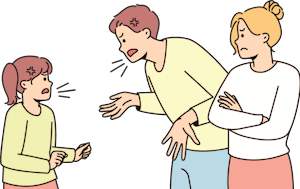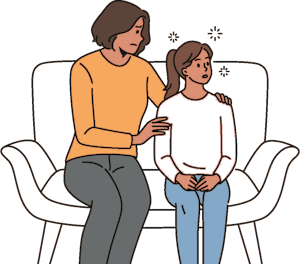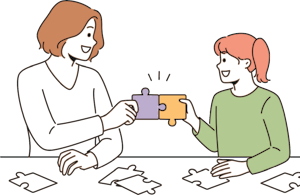Behavior Strategies for Raising Kids with ADHD
Penny Williams
Attention Magazine December 2023
Download PDF
Do punishments have little to no effect on challenging behavior with your child? While parents are taught to use punishment to manage unwanted behavior, it doesn’t really work for kids with ADHD, and it’s not the best approach for any child. As with anything, if you want to change it, you must address why it’s happening. Behavior is no different.
A lot of confusion and frustration can come from behavior that you don’t understand. It’s important to remember that negative or unwanted behavior is rarely what it seems on the surface. In this article, I am applying our Crisis to Clarity Blueprint™ to explore what your child’s behavior is signaling to you, as well as practical strategies that can make a real difference in your and your child’s everyday life.
REFRAME: Shift your perspective
When your child loses it, it can be hard to see their behavior for what it is. It’s difficult to avoid interpreting it as manipulative, intentional, or personal. It feels rude, disrespectful, oppositional, defiant, lazy, and so forth.
That’s why it’s imperative to reframe and adopt a new perspective on behavior—one that is scientifically backed and actually works for kids with ADHD. Understanding that there’s a lot more to behavior than what you see on the surface will help you begin to understand why your child behaves the way they do.
First, it’s crucial to understand that human behavior is an outward representation of your experience in the world, triggered by your biology—specifically your autonomic nervous system and brain. That means it’s often an instinctual response, not an intentional and considered response. For children with ADHD, their biology plays a more significant role in how they behave, and we must take that into consideration too.
Looking at behavior through this biological and neurodivergent lens is often referred to as using a “brain-based lens.” You’re considering more than just what you see on the surface and how the behavior feels to you—you’re considering your child’s neurological differences and how those differences might be affecting their behavior.
If you’re simply judging how the behavior looks and feels, you’re using a “behavior-based lens,” and that lens prevents you from addressing the root causes of behavior, preventing real improvement.
DECODE: Identify the causes of challenging behavior
It’s well established that biology and behavior are deeply interconnected. While your child’s behavior may feel intentional, in reality it is much more likely to be a biological stress response to a situation where their needs are not being met, they feel unsafe (psychologically, socially, or emotionally unsafe), or they aren’t able to meet expectations.
The whys behind the behavior can be complex, and it isn’t always clear what those underlying causes are. It’s our responsibility as the caring adult to decode the behavior and determine what causes and conditions have led to dysregulation and their feeling unsafe. Here are the most common triggers:
- unmet needs
- sensory overwhelm or an uncomfortable environment
- lagging skills (for ADHD these might include emotional regulation, self-regulation, transitioning, time management, maintaining focus, and planning and organization, to name a few)
- expectations that aren’t doable at that time
- feeling a lack of control over what happens to them
- feeling disconnected from others
Once you’ve determined the root cause(s), you can positively impact the behavior by addressing what caused it at its core.
When we understand the reasons behind a child’s behavior, we can begin to offer meaningful help and create a safe and supportive environment.

SUPPORT: What to do when your child is having a hard time
Understanding what’s going on in your child’s body and brain and what causes and conditions trigger their challenging behavior is very helpful, but it’s only the first couple steps to transforming behavior. Now it’s time to tackle what to do in the midst of intensity, aggression, or meltdown. There are certain strategies that are most useful at particular points in these situations, and many that are instinctual for parents, but totally unhelpful.
When a child with ADHD is dysregulated and feeling unsafe, their emotional brain or survival brain has flooded (or both), which cuts off access to the thinking brain. This is why attempting to reason with a child when they are intense or in meltdown never works—because rational thought requires the thinking brain and they can’t access their thinking brain at that time. So talking often escalates the situation instead of helping, because it’s just piling onto the overwhelm they’re already feeling.
Here are strategies that actually help when a child with ADHD is struggling with big emotions or in meltdown:
- Remain calm. If you match your child’s intensity, you’re escalating and prolonging the situation, not to mention modeling exactly what you don’t want your child to do.
- Show empathy. Let your child know that you see their struggle. For example, “I can see that you’re really upset right now. This situation is really hard.”
- Respond, don’t react. Remember, your child isn’t giving you a hard time, your child is having a hard time. Block your reactive instincts and respond with calm compassion.
- Stop talking. This is where most parents fall into the cycle of escalation. As I outlined above, your child’s thinking brain is offline at this time. They cannot process language, so talking adds to the overwhelm. You can help your child through this with your supportive energy and without words.
- Honor what your child needs. Some kids with ADHD need to be left alone to get regulated and recover. For others, that feels like abandonment and escalates the intensity. Know your child and what they need, and honor that for them.

RESTORE: Nurture your relationship with your child
Of course, the goal with challenging behavior—whether it stems from ADHD or something else—is to be proactive and prevent as much of it as possible in the first place. The reframing and decoding steps I’ve already talked about are foundational when it comes to de-escalation and prevention, as is nurturing your relationship with your child.
Your first task in nurturing your relationship with your child is to be a positive counterpoint. Kids with ADHD get exponentially more negative messages than their neurotypical peers, which we know is harmful. That means you must counter that negative messaging with a greater amount of positive messaging for your child’s mental and emotional wellbeing. This will strengthen your relationship from both sides: your child will know that someone sees them for more than just their struggle, and you will get consistent reminders that parenting this child is more difficult, but equally if not more rewarding.
A strong relationship fosters an emotional connection between you and your child, as well. This connection helps them feel understood, supported, and loved, reducing the likelihood of triggering challenging behavior. It creates a positive and supportive environment that fosters emotional wellbeing and regulation. And when we’re regulated and feeling good, we’re able to do good.
When you have a secure relationship with your child, they also feel comfortable and safe to communicate their thoughts and feelings with you. This open line of communication allows you to proactively address any issues or concerns before they escalate.
Nurture your relationship with your child with ADHD by genuinely showing up for them and spending time together without an agenda. Do something with your child that they love without demands, without teaching or correcting, and without judgment. Show interest in their interests. Be real and vulnerable and human in front of them.

EMPOWER: Teach self-regulation
An individual who is regulated feels good and is able to do good. The more time a child is regulated, the more they are able to meet expectations and get things done. But self-regulation can be very difficult for kids with ADHD, especially younger kids, so we must teach these skills.
My favorite way to boost regulation skills in kids is to weave regulation activities into everyday life. It doesn’t add “teaching time” to your already hectic family life and it helps with the tasks that come after. Have your child do a short regulation activity to regulate their nervous system before tasks where they need to be regulated to succeed.
Couple a task that is difficult for your child with ADHD with a regulation activity. Regulating before tasks that are challenging can better prep their system for success with the task. For example, when they wake up in the morning, have your child splash cold water on their face (or use an ice pack on their face or neck) to get regulated so they can focus on completing the steps to get ready for school. Or, have your child blow bubbles before sitting down to dinner. Or, go for a walk before starting homework. Or, shake it out before they climb into bed each night (that’s a good one to get the wiggles out too). Bonus points for doing the regulation activities with them or as a family.
Make regulation activities routine and your child will naturally start using them to self-regulate at some point down the road.
PARENTING A CHILD WITH ADHD may feel like an uphill battle, but with the right understanding and tools, you can transform challenging behavior and help your child thrive. Reframing behavior and decoding its root causes will make a world of difference. By learning to decode and support their needs in the midst of intensity, nurturing your relationship with them, and empowering them with self-regulation tools and strategies, you can transform your child’s behavior and create a safe and supportive environment for your entire family. Remember, by staying compassionate, patient, and focused, you can help your child with ADHD live their best life.
 A parenting coach for neurodiverse families, Penny Williams is the award-winning author of four books on ADHD, including Boy Without Instructions; host of the Beautifully Complex podcast); host of the annual Neurodiversity Summits; and co-creator of The Behavior Revolution Program, a parent training program designed to change the narrative on behavior and help parents celebrate and support their kids with ADHD or autism through neuroscience-backed insights, hard-won strategies, compassion, and guidance. She empowers parents to help their neurodivergent kids—and families—thrive.
A parenting coach for neurodiverse families, Penny Williams is the award-winning author of four books on ADHD, including Boy Without Instructions; host of the Beautifully Complex podcast); host of the annual Neurodiversity Summits; and co-creator of The Behavior Revolution Program, a parent training program designed to change the narrative on behavior and help parents celebrate and support their kids with ADHD or autism through neuroscience-backed insights, hard-won strategies, compassion, and guidance. She empowers parents to help their neurodivergent kids—and families—thrive.
Other Articles in this Edition
Conquer ADHD Sleep Struggles with Support and Accountability
When Someone Shows You Who They Are
School-Based Interventions for Adolescents with ADHD
The Quest for Clinical Practice Guidelines for ADHD in Adults
Behavior Strategies for Raising Kids with ADHD
Checking Homework: Track Assignments with a Single Sign-On
